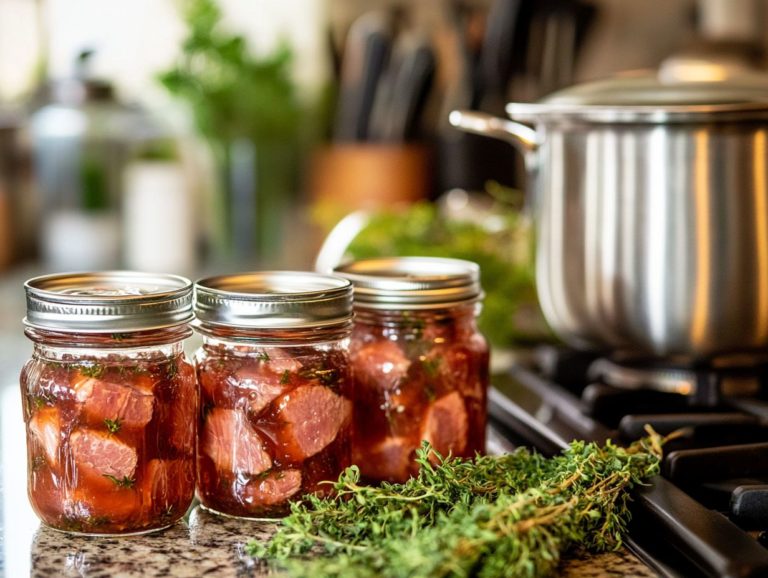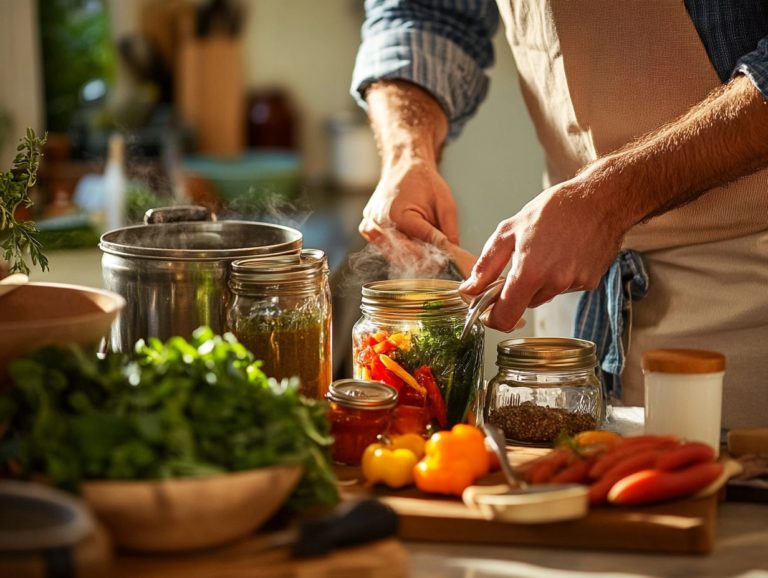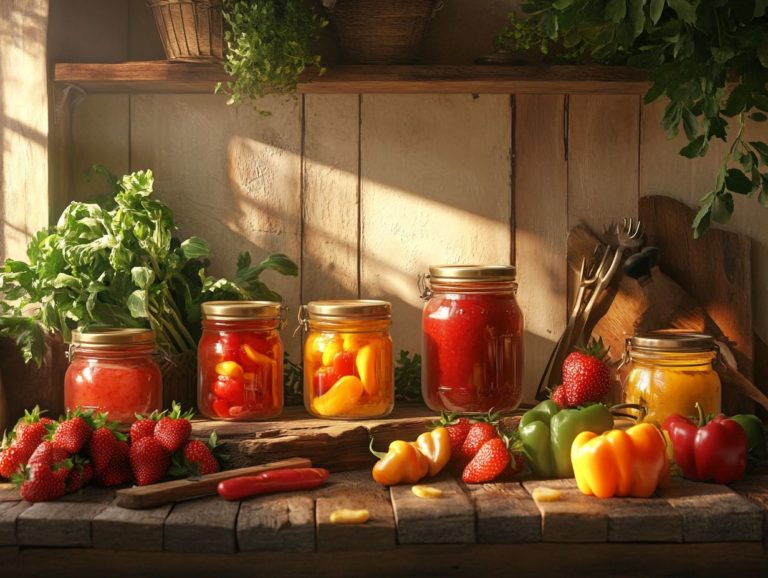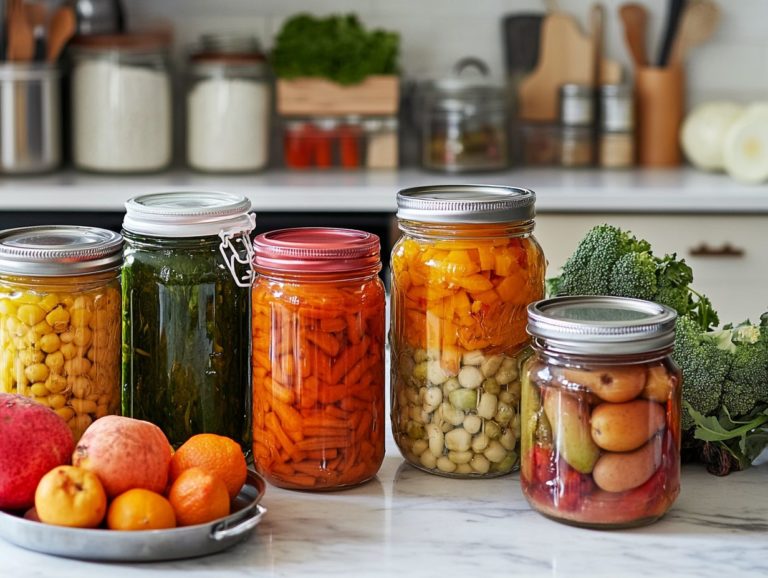How to Plan Your Canning Schedule
Planning your canning schedule is crucial for a successful harvest season and effective food preservation. By thoughtfully considering factors such as produce availability and storage space, you can optimize your efforts and resources while incorporating seasonal living practices.
This guide will assist you in assessing your needs, crafting a manageable timeline, and determining what to prioritize for canning recipes. You ll also discover valuable tips for organizing and labeling your jars, ensuring your pantry remains efficient and enjoyable, especially during the canning season.
Prepare to elevate your canning experience and embrace the joys of gardening and preserving harvest to new heights!
Contents
Key Takeaways:
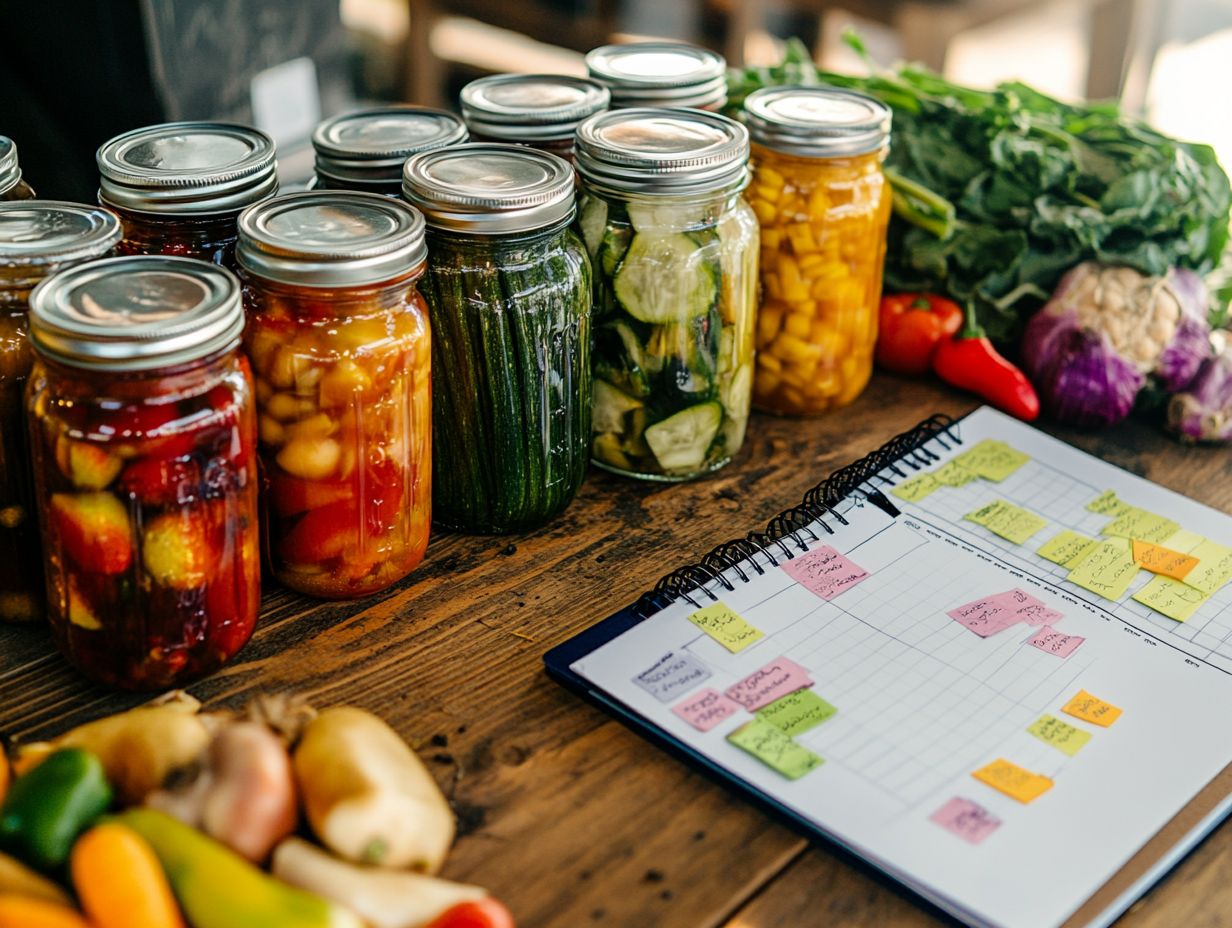
- A well-planned canning schedule ensures you have preserved food throughout the year, including your wish list of seasonal flavors.
- Consider harvest season, availability of fresh produce, and storage space when planning your canning schedule. Also, evaluate your storage space and ensure you have the canning tools you need.
- Assess your needs and goals, create a timeline, and prioritize preserving vegetables and fruits for efficient canning.
Why is a Canning Schedule Important?
A canning schedule is essential for maximizing the efficiency and effectiveness of your food preservation efforts, especially during the canning season when fresh produce is plentiful from local farms and your own garden.
By keeping your canning organized, you can make the most of your tools and stock jars, ensuring that none of your hard-earned harvest goes to waste. This approach allows you to plan your canning recipes in advance think crushed tomatoes, apple butter, and more fitting seasonal flavors and preserving techniques seamlessly into your routine.
Not only does this structured method streamline your canning sessions, but it also optimizes your storage space, resulting in a neat and accessible pantry filled with jars of vibrant fruits, savory sauces, and delightful jams. Having a set schedule diminishes the chances of food waste, particularly when certain produce is available for only a short time.
By timing your canning activities strategically, you can capitalize on fresh ingredients from your gardening season and transform them into long-lasting staples for your home. Understanding the impact of seasonal produce on canning is essential for a well-planned canning schedule, which is your key to savoring the flavors of each season. Don’t let your harvest go to waste; act now to create sustainable food storage solutions!
Factors to Consider when Planning Your Canning Schedule
When you are charting out your canning schedule, it’s essential to take several key factors into account to guarantee that your food preservation efforts are not just effective but also sustainable and in harmony with seasonal eating practices. For optimal results, consider how to use a canning book effectively.
You’ll want to grasp the nuances of the harvest season and the availability of fresh produce. Understanding the harvest season and the availability of seasonal produce is essential for crafting a successful canning schedule. This knowledge gives you the power to plan your canning recipes around the freshest and most flavorful ingredients, whether they come from local farms or your own garden.
Throughout the year, different fruits and vegetables showcase their best selves at various times. Summer gifts you with an abundance of juicy tomatoes, sweet peaches, and luscious berries, while fall invites hearty squash, crisp apples, and robust root vegetables to the table.
By knowing when to expect these harvests, you enrich your canning experience, allowing you to capture the essence of each season. For instance, the vibrant flavors of summer tomatoes can be transformed into zesty salsa or rich marinara, while autumn apples lend themselves beautifully to fragrant spiced preserves.
This seasonal approach not only elevates taste but also supports local agriculture and sustainable practices, creating a deeper connection to the rhythms of nature in a meaningful way.
Start planning your canning schedule today and make the most of your harvest season!
Storage Space and Equipment Availability
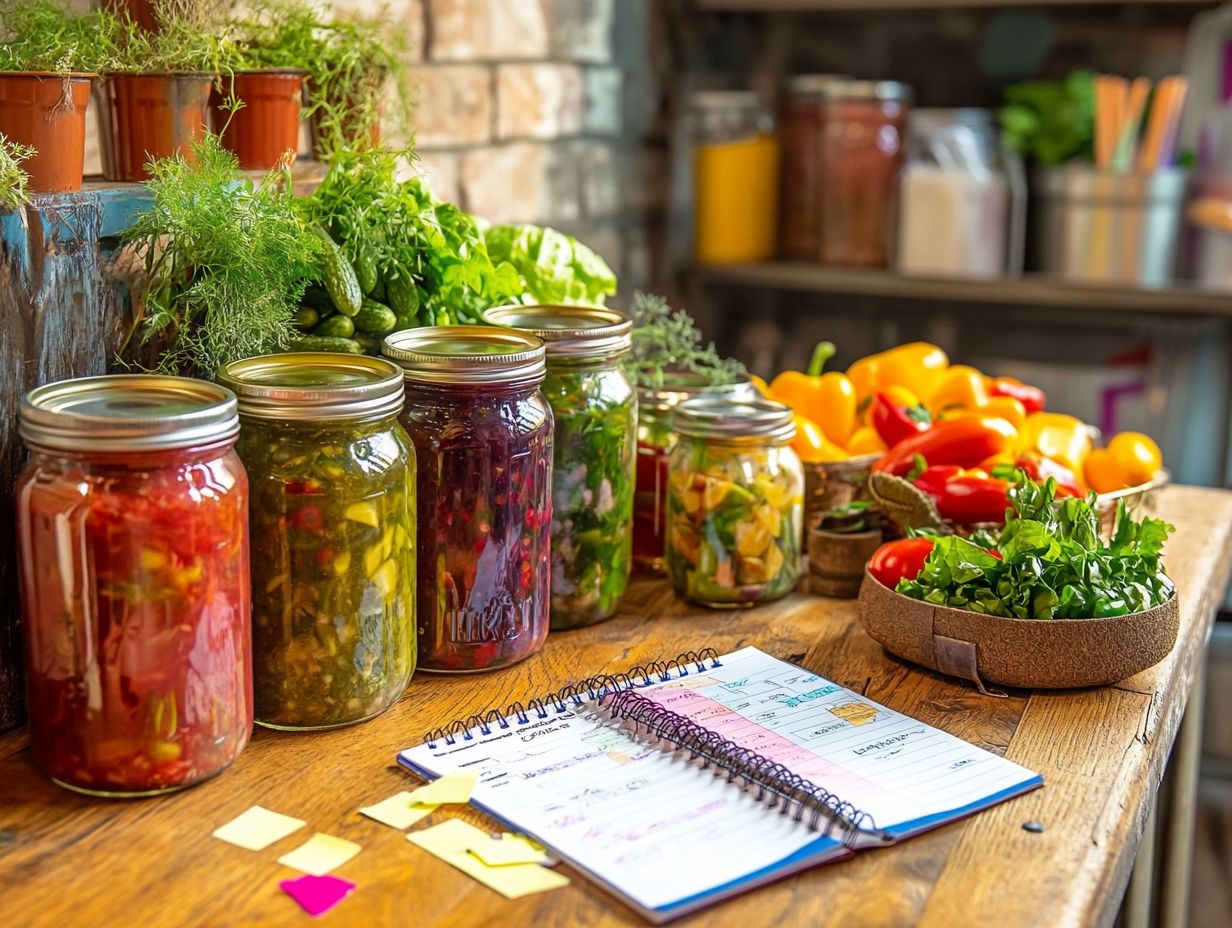
Adequate storage space and the right canning equipment, including pressure canners and water bath canners, are essential for successful food preservation. They determine how effectively you can organize your kitchen supplies and manage your inventory.
Ensuring you have all the jars and materials necessary for the canning process sets you up for a fruitful canning season. This preparation helps maintain the quality of both your raw ingredients and finished products.
Utilizing various canning equipment pressure canners for low-acid foods and water bath canners for high-acid fruits and vegetables significantly enhances your preservation effectiveness.
To elevate your kitchen organization, consider labeling your jars clearly and designating specific areas for different ingredients. This will help during winter storage and make locating what you need easy, especially with an inventory check system to track your home preserving.
Implementing a first-in-first-out system will further aid in using older supplies before newer ones. This minimizes waste and maximizes efficiency in your canning endeavors.
Step-by-Step Guide to Planning Your Canning Schedule
Crafting a comprehensive canning schedule demands a careful, step-by-step approach that focuses on preserving food effectively. To optimize your efforts, consider the best times of year for canning as you start by evaluating your needs and goals regarding food preservation.
Next, develop a well-structured preserving plan that aligns with your seasonal living and gardening endeavors. This thoughtful preparation ensures your canning efforts are both efficient and rewarding.
Assessing Your Needs and Goals
Assessing your needs and goals is the cornerstone of crafting an effective canning schedule. This includes understanding the quantities of fruits and vegetables you plan to preserve. Pinpoint which fruits and vegetables you want to preserve and determine the quantities required for your homemade meals.
Select specific canning recipes that resonate with your seasonal eating preferences. Consider your family size and dietary preferences, as these factors greatly influence the types of preserved foods you choose to prepare.
If you have a larger family, you might lean toward bulk recipes that yield higher quantities. Conversely, if you or your family members have specific dietary restrictions, seek out recipes that accommodate gluten-free or low-sugar requirements.
Understanding these individual needs allows you to create a tailored approach. This ensures your food preservation goals are met while minimizing waste. Embracing seasonal flavors is essential; using peak produce elevates taste and maximizes nutritional value.
Creating a Timeline and Prioritizing Produce
Creating a timeline and prioritizing produce based on their harvest seasons is crucial for developing a canning schedule that maximizes efficiency. This also ensures your preserved foods maintain their peak freshness and flavor.
Align your canning timeline with the harvest calendar to elevate the quality of your preserves. Begin by assessing which fruits and vegetables are in season and readily available, allowing you to create a seasonal overview for your canning recipes.
Focus first on items with shorter shelf lives, like berries and leafy greens. Process these treasures as soon as possible to prevent spoilage and fully capitalize on their vibrant flavors.
Next, turn your attention to items that endure a bit longer, such as tomatoes and root vegetables. These can be canned in larger batches. This smart strategy maximizes your pantry space while ensuring you’re savoring the finest taste and nutritional benefits throughout the year.
Tips for Efficient Canning and Storage
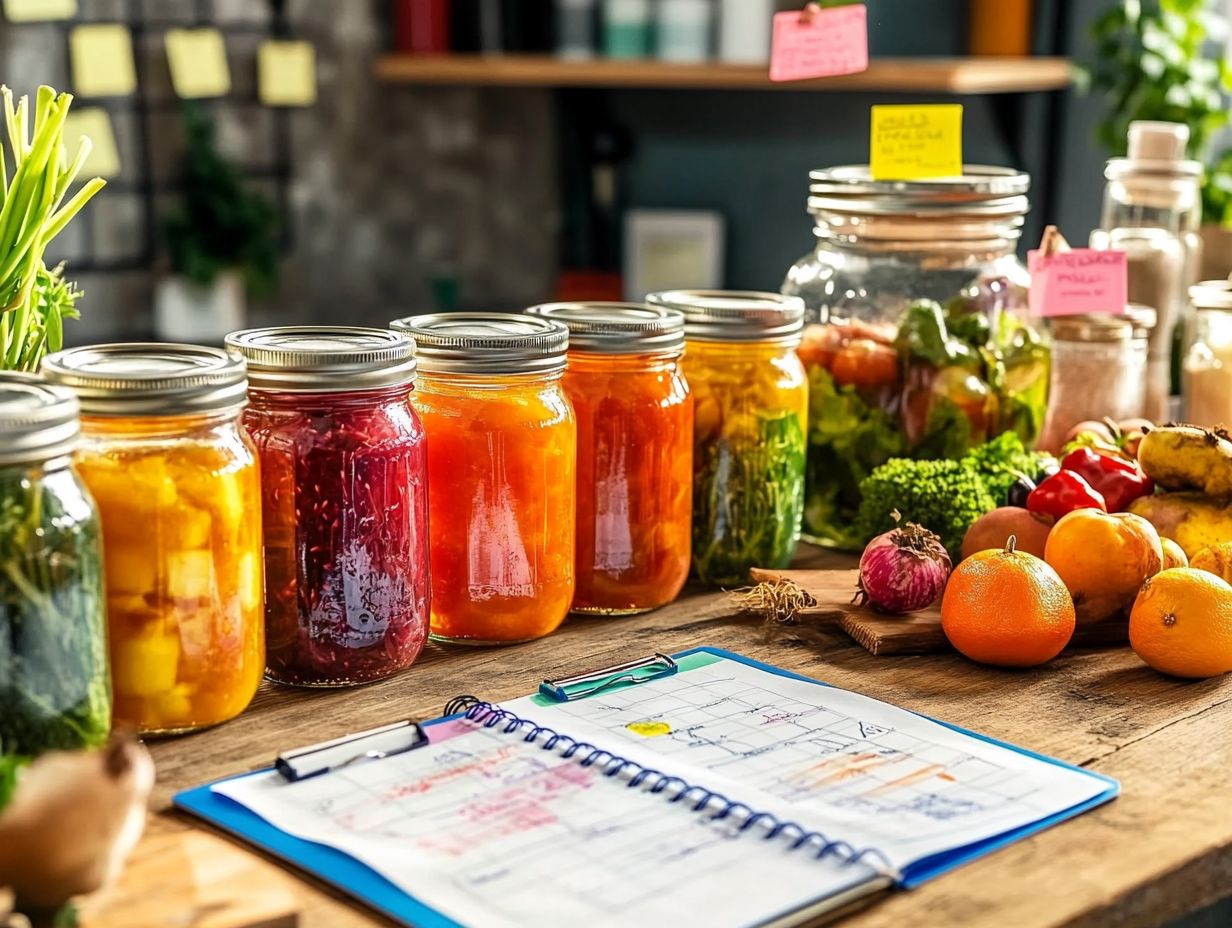
To achieve a successful canning season, you should embrace tips for efficient canning and storage. These strategies not only elevate the canning process but also optimize the space in your kitchen and pantry, ensuring your organized jars remain easily accessible.
Maximizing Space and Resources
Maximizing space and resources in your kitchen is essential for any person who cans food. Efficient use of your canning equipment, including pressure canners (a special pot for canning that uses steam) and smart pantry organization, can drastically reduce clutter while elevating your overall food preservation efforts.
Keep your canning tools within easy reach. Utilize vertical storage solutions to transform a cluttered kitchen into a streamlined workspace. For instance, installing shelving units or hanging racks can free up valuable countertop space, giving you more room for food preparation and processing.
Organizing jars and lids effectively helps you minimize the time spent rummaging through cabinets, leading to a more efficient food storage system. Make these simple changes to enjoy a better canning experience!
Organizing and Labeling Jars
Organizing and labeling jars is an essential practice in food preservation. This not only helps maintain an orderly pantry but also ensures you can quickly identify various home-canned food items during the winter storage months.
A well-structured labeling system enhances the overall efficiency of your food storage, allowing you to find exactly what you need without the hassle of rummaging through jars. By clearly marking the contents and canning dates, you can effortlessly keep track of your inventory, ensuring that older items are used first and minimizing food waste.
Use waterproof labels to keep your jars organized with a consistent format that includes both the type of food and the canning date. This careful system preserves your canned goods’ quality. It also makes meal planning easier, ultimately optimizing your kitchen supplies for a smoother, more enjoyable cooking experience.
Frequently Asked Questions
What is canning and why is it important to plan a schedule?
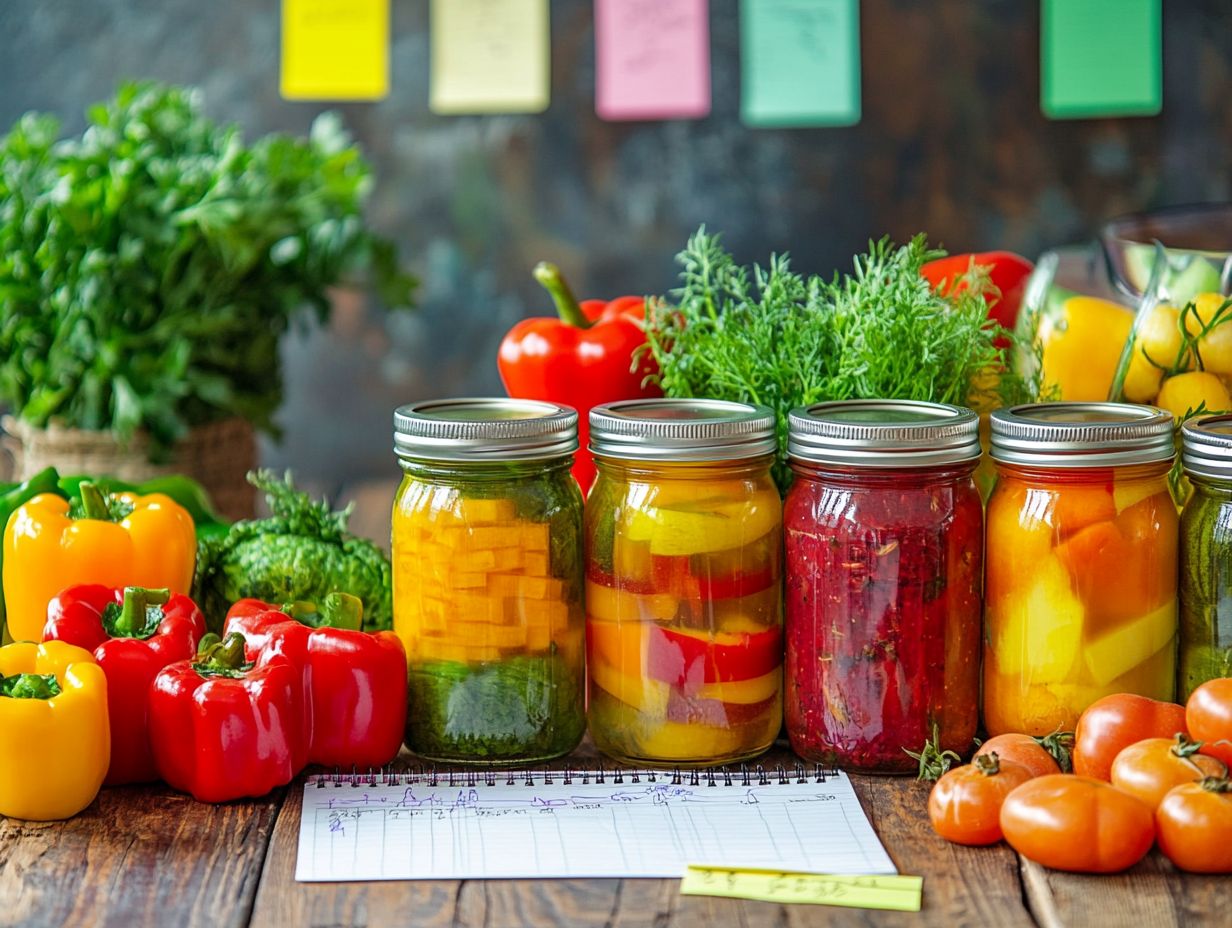
Canning is a method of preserving food by sealing it in airtight containers. It is important to plan a schedule because it helps ensure that you have all the necessary ingredients and equipment, and that you have enough time to complete the canning process properly.
How do I determine what foods to can and when?
The best way to determine what foods to can is to check what is in season. Canning foods when they are at their peak ensures the best flavor and quality. You can also consider what your family enjoys eating and what you have an abundance of in your garden.
Do I need any special equipment to can my own food?
Yes, you will need a few key pieces of equipment to safely can your own food. This includes a pressure canner or water bath canner, canning jars, lids, and bands, along with basic kitchen tools such as a pot holder, tongs, and a ladle.
How do I create a canning schedule?
The first step in creating a canning schedule is to take inventory of the foods you want to can and the amount you have. Then, determine the processing time for each type of food and schedule accordingly. For a more organized approach, check out this guide on how to plan a canning party. It’s also important to leave enough time for prep work and clean up between batches.
Can I change my canning schedule if necessary?
Of course! Flexibility is key when it comes to canning. If you are short on time or ingredients, you can always adjust your schedule or switch to canning a different type of food. However, it’s important to follow proper canning guidelines to ensure the safety and quality of your canned goods.
Start your canning journey today and make the most of your seasonal harvest!
What is the shelf life of canned food and how should it be stored?
Canned food can last for up to a year when kept in a cool, dark place. Always check the seals and lids for any damage before consuming.
Once opened, store canned food in the fridge. Enjoy it within a few days for the best flavor!


